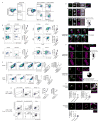Anabolism-Associated Mitochondrial Stasis Driving Lymphocyte Differentiation over Self-Renewal
- PMID: 28009285
- PMCID: PMC5189677
- DOI: 10.1016/j.celrep.2016.11.065
Anabolism-Associated Mitochondrial Stasis Driving Lymphocyte Differentiation over Self-Renewal
Abstract
Regeneration requires related cells to diverge in fate. We show that activated lymphocytes yield sibling cells with unequal elimination of aged mitochondria. Disparate mitochondrial clearance impacts cell fate and reflects larger constellations of opposing metabolic states. Differentiation driven by an anabolic constellation of PI3K/mTOR activation, aerobic glycolysis, inhibited autophagy, mitochondrial stasis, and ROS production is balanced with self-renewal maintained by a catabolic constellation of AMPK activation, mitochondrial elimination, oxidative metabolism, and maintenance of FoxO1 activity. Perturbations up and down the metabolic pathways shift the balance of nutritive constellations and cell fate owing to self-reinforcement and reciprocal inhibition between anabolism and catabolism. Cell fate and metabolic state are linked by transcriptional regulators, such as IRF4 and FoxO1, with dual roles in lineage and metabolic choice. Instructing some cells to utilize nutrients for anabolism and differentiation while other cells catabolically self-digest and self-renew may enable growth and repair in metazoa.
Keywords: Pax5; TCF1; Warburg effect; asymmetric cell division; self-renewal; stem cell.
Copyright © 2016 The Author(s). Published by Elsevier Inc. All rights reserved.
Figures




References
-
- Bengsch B, Johnson AL, Kurachi M, Odorizzi PM, Pauken KE, Attanasio J, Stelekati E, McLane LM, Paley MA, Delgoffe GM, et al. Bioenergetic Insufficiencies Due to Metabolic Alterations Regulated by the Inhibitory Receptor PD-1 Are an Early Driver of CD8(+) T Cell Exhaustion. Immunity. 2016;45:358–373. - PMC - PubMed
-
- Caro-Maldonado A, Wang R, Nichols AG, Kuraoka M, Milasta S, Sun LD, Gavin AL, Abel ED, Kelsoe G, Green DR, et al. Metabolic reprogramming is required for antibody production that is suppressed in anergic but exaggerated in chronically BAFF-exposed B cells. J Immunol. 2014;192:3626–3636. - PMC - PubMed
MeSH terms
Substances
Grants and funding
LinkOut - more resources
Full Text Sources
Other Literature Sources
Molecular Biology Databases
Research Materials
Miscellaneous

